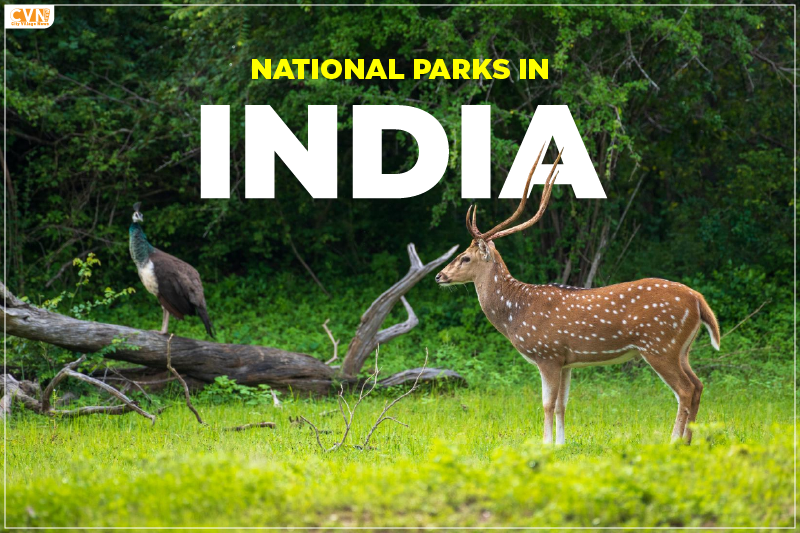Why national parks?
National parks are built on the central idea of the conservation of plant and animal species. These parks give shelter to various plants and animals, allowing them to remain in their own element, away from human destruction. These parks are usually the best places in India to understand more about animals in their natural habitats.
In the colonial era, the British elite in India, as a hobby, went to forests and amused themselves by fighting tigers and lions to death. They used to flaunt their kill and capture, something that is now considered illegal. This was one of the reasons that the tiger had almost become extinct in the country. It is now one of the protected animals. Harming or poaching such animals is now prohibited and subject to severe penalties.
Hence, it makes sense that national parks exist in India. They have now become tourist spots to visit and experience wildlife in real life. There are many national parks in India that protect and preserve wildlife.
Jim Corbett National Park
Corbett National Park is situated in the Nainital district of the state of Uttarakhand. It was the first national park in India to be established and also, later, the first to come under the Project Tiger initiative to protect tigers. It is most famous for having the largest number of tigers than any other national park in the country. It is the best national park to see tigers.
Initially, when it was established in the year 1936, it was named Hailey National Park, after the Governor of the United Provinces (of which Uttarakhand was a part), William Malcolm Hailey. Since Jim Corbett, a naturalist, had actually played a very significant role in its establishment, a year after he died, in the year 1956, the park was renamed to Corbett National Park.
The most exciting part about Corbett National Park is not its wildlife tours, but the fact that it is the only one to offer night stays in its forests. It also has a few additional offers, such as Corbett Safari Booking, Night Stay Booking, Corbett Tour Packages, and Dhikala Forest Booking.
Sariska National Park
The Sariska National Park, located in Rajasthan, is an asylum for Royal Bengal tigers. It is nestled in the Aravali Ranges, surrounded by rocky hills, grasslands, dry deciduous forests, and steep cliffs – a great place for animals such as tigers.
Before it was declared as a natural reserve in the year 1958, this area was a hunting reserve of the Alwar State. Two decades later, in the year 1978, it came under the Project Tiger initiative when it became a tiger reserve.
The Sariska National Park not only houses tigers, but also leopards, the Hanuman Langurs, the Indian Horned Owls, Chital, and many varieties of bird species. For its visitors, it offers some tour packages, such as: Sariska Weekend Getaway, National Parks with Taj Mahal Tour, 6 Nights/7 Days Tour, Sariska Tour, Sariska Weekend Tour Package, and 1 Night/2 Days Package.
Manas National Park
Located in the state of Assam, at the foothills of the Himalayas, Manas National Park is a UNESCO Natural World Heritage site, hence one of the most famous national parks in India. It is a tiger national park in India, an elephant reserve, as well as a biosphere reserve. It is associated with Royal Manas National Park in the neighboring country of Bhutan. The Manas River, a major tributary of the Brahmaputra River, runs through the heart of this park; hence, its name.
Before it became a national park, the area of the park was a reserved forest called Mana R F and North Kamrup R F. On 1 October 1928, it was declared as a sanctuary. Then, in the year 1973, a bio reserve was established here. 56 villages surround the park and 1 village is located in its center.
Manas National Park is well-known the world over as harboring rare and endangered species, such as Assam roofed turtle, hispid hare, golden langur, and pigmy hog.
Bannerghatta National Park
Bannerghatta National Park is located in the state of Karnataka, near its capital, Bangalore. It consists of some ancient temples; it also has great spots for hiking and trekking.
The park was founded in the year 1970; four years later, in 1974, it was declared as a national park. In 2002, a small portion of it was made a zoological park—the Bannerghatta Biological Park.
Bannerghatta National Park houses a lot of flowers – such as, sandalwood, neem, and tamarind – and animals – such as, cobra, elephant, and the Royal Bengal Tiger.
Dachigam National Park
Dachigam National Park is located near Srinagar in the region of Jammu and Kashmir. The name literally translates to “ten villages”—named after the fact that ten villages had to be relocated to create space for this park, before the First World War.
The area became protected in the year 1910, under the Maharaja of Jammu and Kashmir, before the independence of India, to ensure that clean drinking water would be supplied to Srinagar. Post-independence, it came under the protection of the concerned government authorities.
Dachigam National Park houses a number of flowers, birds, and animals. Some of the species here are musk deer, snow leopard, cinnamon sparrow, and pygmy owlet.
Eravikulam National Park
Eravikulam National Park is located in the Western Ghats in Kerala, near Munnar. It is the first national park that came up in this state.
Before 1971, the area of the Eravikulam National Park was managed by Kanan Devan Hills Produce Company as a game reserve – that is, a place reserved for hunting animals. In the year 1971, the state government of Kerala assumed control of it; four years later, in 1975, the government declared the Eravikulam-Rajamala Wildlife Sanctuary to protect the habitat of an endangered animal called the Nilgiri tahr, a species of ram.
A new species of frog was discovered here that was given the name, Raorchestes resplendens.
Are there any other national parks in India you have visited that haven’t made the list? Please comment below to let us know!

